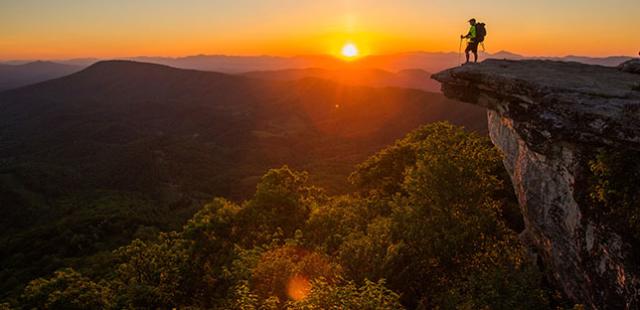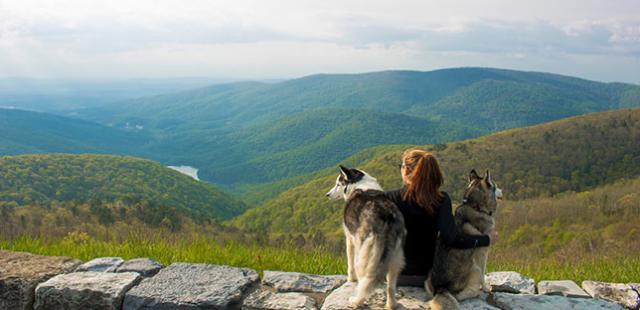Shenandoah National Park
When mentioning Shenandoah National Park, visitors often get that faraway look in their eye, fondly recalling adventures at this scenic mountain jewel rising high atop Virginia’s Appalachians. What makes Shenandoah so special? First, consider panoramic views from overlooks scattered on lofty Skyline Drive, which runs 105 miles down the length of the 300-square-mile sanctuary. Additionally, beyond Skyline Drive lies another Shenandoah, where bears roam the hollows and brook trout ply the tumbling streams. Trail side flowers color the woods. Quartz, granite, and greenstone outcrops jut above the diverse forest, allowing far-flung views of the Blue Ridge and surrounding Shenandoah Valley. It is this beauty near and far that create the unforgettable Shenandoah experience.
Shenandoah -- the first of Virginia’s national parks -- was dedicated July 3, 1936. Cobbled together along the Blue Ridge from Front Royal to Waynesboro, the long narrow preserve divides the proud Shenandoah Valley from the rolling Piedmont to the east. The park contains a wide array of flora and fauna as it rises from a mere 550 feet at its lowest elevation to over 4,049 feet at its highest atop Hawksbill.
-
KNOW BEFORE YOU GO
- Shenandoah National Park has an entrance fee, payable at one of the four major entrance stations. The fee is good for 7 consecutive days, even if you leave the park.
- The weather tends to be up to 10 degrees cooler than the surrounding lowlands, a good thing in summer.
- Although supplies are limited in the park, fuel is available 24/7 at Big Meadows Wayside.
- Skyline Drive closes during bad weather. If you have weather concerns, call (540) 999-3500, 1, 1 to see if Skyline Drive is open.
- The Park has three districts, each with its own characteristics - North, Central and South. Explore each district. Try new places and discover new wonders of Virginia’s biggest and oldest national park.
- Stop by any Virginia Welcome Center to pick up a park guide with a convenient pull out map of Shenandoah National Park.
Can't Miss Hikes in Shenandoah National Park
The wild and less seen side of Shenandoah awaits those who leave Skyline Drive behind, and take to their feet. The rewards increase with every footfall beneath the stately oaks to rocky vista points and into deep canyons where waterfalls roar among old-growth trees spared by the logger’s axe. In other places, your footsteps lead past what once were hardscrabble farms -- Shenandoah’s pioneer past. Discover both the human and natural history of Shenandoah. A foray into the backcountry complements your views from Skyline Drive. Here are some recommended hikes, providing a sample of the best hikes and walking trails in Shenandoah National Park:
Hikes under 2.5 Miles
Fox Hollow Trail
Milepost 4.6
1.2 miles
Compton Peak
Milepost 10.4
2.2 miles
An easy hike with two viewpoints. The east viewpoint is a geologic phenomenon called columnar jointing, which is caused by rapid cooling of molten lava. The west viewpoint is of the beautiful Shenandoah Valley.
Hawksbill Summit
Milepost 46.7
2.2 miles
This favorite hike starts high and gets to the top of Shenandoah. Traverse a “sky island” of Canadian-type forest. Enjoy the nearly 360-degree view from the summit.
Blackrock Loop
Milepost 84.8
1.1 miles
Loop around Blackrock using the Appalachian Trail to reach an incredible rock jumble with views extending for miles. Ambitious visitors will scramble among the boulders.
Sampler Hikes from 2.5 to 8 Miles
Big Devils Stairs Vista
5.0 miles
Start by passing a shelter used by long-distance hikers on the Appalachian Trail. Join the nearly level Bluff Trail to the Big Devils Stairs canyon rim for a great view, minus crowds.
Lewis Spring Falls Loop
3.3 miles
Walk Lewis Spring Fire Road, then northbound on the AT, climbing to Blackrock (the north Blackrock, there are two Blackrocks at Shenandoah) and its stellar views. View more rock features, then visit loud and dramatic Lewis Spring Falls.
Hazeltop/Rapidan Camp Loop
Milepost 52.8
7.2 miles
Walk over Hazeltop, third highest peak in the park, and then follow Laurel Prong down to Rapidan Camp, the woodland getaway for President Herbert Hoover. Take a self-guided interpretive tour then view Big Rock Falls along the way to the trailhead.
Falls Loop from Browns Gap
Milepost 83.0
7.0 miles
The loop passes three major cataracts and numerous other cascades as it explores two boulder-strewn canyons linked by the Appalachian Trail. Find old-growth tulip trees with impressive girths.
Places to Stay in Shenandoah National Park
Campgrounds, cabins and lodges stretch from one end of Shenandoah National Park to another. Choose your overnighting venue and you don’t have to leave the park.
Camping in Shenandoah National Park is a great way to experience the park. Campers can choose from four campgrounds, each located in different locales of the park to suit your desires.
Camping and Campgrounds
Mathews Arm
Milepost 22.2
Elevation 2,920 feet
The hilly campground has first come, first served and reserved sites, most of which are shaded. There are some pull-through sites for camper rigs. During the week sites are almost always available. The higher elevation keeps it a good 10 degrees cooler than the Shenandoah Valley below.
Big Meadows
Milepost 51.0
Elevation 3,480 feet
Conveniently located near all the action at the greater Big Meadows activity complex, this highest campground has tent sites, pull through sites for pop-ups and campers, and walk-in tent sites in a generator-free zone. Showers are available, a camp store, too. The campground is a refreshing summer getaway yet close to conveniences offered at the nearby Big Meadows Lodge. Reservations and walk up campsites available.
Lewis Mountain
Milepost 57.5
Elevation 3,390 feet
This is the most centrally located of all Shenandoah’s campgrounds and the smallest. The 30-site locale offers first come, first served sites only, though hot showers can be had.
Loft Mountain
Milepost 79.5
Elevation 3,320 feet
The only campground in the South District, this is also Shenandoah’s largest camp, and has a camp store and showers. The Appalachian Trail circles around the campground, highlighting the richness of hikes nearby. There are lots of pull-through sites for campers and RVs, but also walk-in tent sites. Certain sites can be reserved.
Cabins and Lodges
Two traditional national park lodges combined with historical cabins add up to good choices for those who want to overnight in the park without roughing it.
Skyland Lodge
Milepost 41.7
Elevation 3,680 feet
Visitors have been coming to Skyland since the late 1800s, when Shenandoah proponent George Pollack ran a lodge here. There are still preserved buildings from the old days, and Skyland offers little cabins and a variety of rooms overlooking the landscape often surprise first time lodgers. On-site dining adds to the experience.
Big Meadows Lodge
Milepost 51.0
Elevation 3,610 feet
The main lodge was built in 1939, giving it a rustic flair. The Great Room of the lodge lives up to expectations. Nature lies just outside the big windows. Additional lodging and cabins have been added. The locale offers three levels of rooms. The small cabins are for solitude lovers. On site dining is available. The lodge’s location is ideal for exploring Shenandoah activities and sights near and distant.
Lewis Mountain Cabins
Milepost 57.5
Elevation 3,390 feet
These rustic cabins from the 1930s deliver a backwoods touch to your Shenandoah experience. The 15 cabins are clustered near the Lewis Mountain campground. A camp store has supplies and showers for this secluded destination that allows easy access to the Appalachian Trail. It runs just behind the cabins. Other hiking opportunities are nearby. Bring your own cooler, as the cabins don’t have refrigerators.







